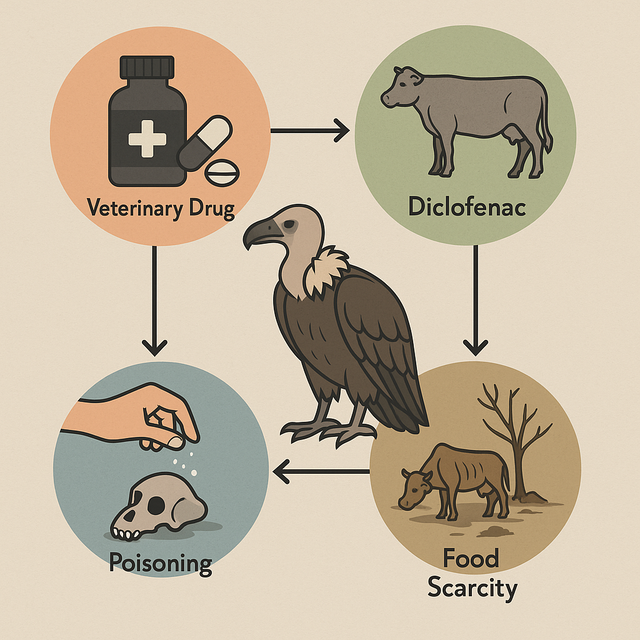শকুন লুপ্তপ্রায়
নমস্কার বন্ধুরা,
শকুন দক্ষিণ এশিয়া, বিশেষত ভারতীয় উপমহাদেশে একসময় প্রচুর সংখ্যায় দেখা যেত।কিন্তু গত কয়েক দশকে এদের সংখ্যা হঠাৎ করেই ভয়াবহভাবে হ্রাস পেয়েছে।এর মূল কারণ হলো মানুষের ব্যবহৃত কিছু ওষুধ এবং পরিবেশগত পরিবর্তন।সবচেয়ে গুরুত্বপূর্ণ কারণ হলো গবাদি পশুর চিকিৎসায় ব্যবহৃত ডাইক্লোফেনাক (Diclofenac) নামের একটি ব্যথানাশক ওষুধ।
অসুস্থ গরু বা মহিষকে এই ওষুধ দেওয়ার পর যখন তারা মারা যায়,তখন তাদের মৃতদেহ খাওয়ার মাধ্যমে শকুনের শরীরে এই ওষুধ প্রবেশ করে।শকুনের কিডনিতে এই ওষুধ মারাত্মক ক্ষতি করে এবং অল্প সময়ের মধ্যেই তাদের মৃত্যু ঘটে।গবেষণায় দেখা গেছে, খুবই অল্প পরিমাণ ডাইক্লোফেনাকও শকুনের জন্য প্রাণঘাতী।
এছাড়া খাদ্যের ঘাটতি শকুনের বিলুপ্তির আরেকটি বড় কারণ।গ্রামীণ অঞ্চলে পূর্বে যেভাবে পশুর মৃতদেহ উন্মুক্ত স্থানে ফেলে রাখা হতো,এখন পশু-পালনের ধরণ পরিবর্তনের কারণে এবং শহুরে বর্জ্য ব্যবস্থাপনা কঠোর হওয়ায় সেই সুযোগ অনেকটাই কমে গেছে।ফলে শকুন তাদের প্রাকৃতিক খাদ্য উৎস হারাচ্ছে।
পরিবেশ দূষণ ও কীটনাশকের প্রভাবও শকুন বিলুপ্তিতে ভূমিকা রেখেছে।ফসলের মাঠে ব্যবহৃত রাসায়নিক কীটনাশক ও বিষাক্ত পদার্থ খাদ্যচক্রের মাধ্যমে শকুনের শরীরে প্রবেশ করে।এগুলো তাদের রোগ প্রতিরোধ ক্ষমতা কমিয়ে দেয় এবং ডিমের খোলস দুর্বল করে ফেলে ফলে প্রজনন কমে যাচ্ছে।
শকুন প্রকৃতির জন্য অত্যন্ত গুরুত্বপূর্ণ কারণ তারা মৃতদেহ খেয়ে পরিবেশকে পরিষ্কার রাখে এবং রোগবিস্তার রোধ করে।কিন্তু তাদের সংখ্যা কমে যাওয়ায় মৃত প্রাণীর দেহ সহজে পচে যেতে পারে না যা নানা রোগ ও জীবাণুর বিস্তার ঘটাতে পারে।এজন্য ভারতসহ বিভিন্ন দেশে শকুন রক্ষায় ডাইক্লোফেনাক নিষিদ্ধ করা হয়েছে এবং শকুন প্রজনন কেন্দ্র গড়ে তোলা হয়েছে।তবে প্রজনন হারের ধীর গতি এবং পরিবেশগত ঝুঁকির কারণে শকুন এখনো বিলুপ্তির দ্বারপ্রান্তে।
VOTE @bangla.witness as witness

OR
| 250 SP | 500 SP | 1000 SP | 2000 SP | 5000 SP |






Congratulations, your post has been upvoted by @nixiee with a 8.552116840893731 % upvote Vote may not be displayed on Steemit due to the current Steemit API issue, but there is a normal upvote record in the blockchain data, so don't worry.
I don't think that their disappearance is caused by the medications given to cows. If these birds don't find anything to eat, they will definitely change their hunting grounds. This means that they have moved to another place.
Absolutely fascinating post, @swagata21! Your deep dive into the alarming decline of vultures in South Asia, especially the Indian subcontinent, is incredibly important. Highlighting the devastating impact of Diclofenac on these vital scavengers is crucial for raising awareness. The way you've explained the cascade effect – from medicated livestock to the vultures' tragic demise – is both clear and compelling.
It's also great that you touched upon other contributing factors like food scarcity and environmental pollution. The call to action, mentioning the ban on Diclofenac and the establishment of breeding centers, provides a glimmer of hope. Your post brilliantly combines scientific insight with an urgent plea for conservation. Thank you for shedding light on this critical environmental issue! I hope more people read and engage with this post.